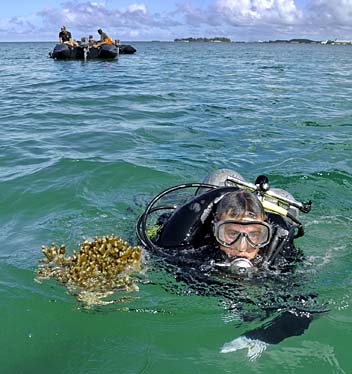
|
Transplanting coral
Army divers move the isle
marine life out of harm's way
A few years ago, Jim Lakey could see that coral in the boat channel of the University of Hawaii Institute of Marine Biology would soon be scratching boat hulls.
Every researcher who works on Coconut Island, where the institute is located, has to get there by boat -- as do all the institute's equipment and supplies.
So letting coral continue to grow into the Kaneohe Bay channel was not an option, said Lakey, who manages the institute's labs. But knocking out living coral -- even if it were permitted -- would not sit well with the scientists who study them.
Yesterday, Lakey proudly showed off his multiagency solution: Army divers from Fort Shafter's 29th Engineer Battalion are relocating coral from the channel to a nearby reef area that needed new growth.
"It's the right thing to do," Lakey said yesterday as he escorted journalists by boat to see the work in progress.
If the work was not done now, "in three to five years, we'd be blocked from using this area," Lakey said.

And it benefits the coral.
Though larger coral heads are broken into pieces to move them, experts believe they will be firmly attached in their new spots and thriving within months, Lakey said. Coral biologist Paul Jokiel checked out the replant area and said, "Just put it there and it'll do fine," according to Lakey.
The U.S. Army Corps of Engineers and state Department of Land and Natural Resources approved necessary permits for the work.
But the Army made it all possible, Lakey said, noting that the work its team of 10 divers and a supervisor are providing would cost "millions" if it had to be contracted.
Members of the 7th Engineer Dive Team who worked on the project this week have experience ranging from four months to 10 years, said team leader Capt. Scott Miller.
The divers' tools are simple: hammers and pry-bars. In water up to 20 feet deep, they loosen coral from the channel wall or bottom. Then they load 20- to 30-pound chunks of live coral into a 5-by-10-foot wire and metal basket, Lakey said.
The basket of coral is winched up against the bottom of inflatable boats and moved to the planting grounds, without the coral ever leaving the water. Since starting Nov. 30, the team has worked 12-hour days moving about 10 loads of coral daily. They even spend the night on the island so there is no time wasted in commuting. "These guys have done the Army proud," Lakey said.
Though the divers can hone their underwater skills in mock situations, "a project with a goal makes it relevant," Miller said.
The goal for this project is to relocate 10,000 square feet of rice coral (Sp. Montipora) and finger coral (Porites compressa), Lakey said. It will probably take until June to complete as the divers fit the work in between other obligations, he said.
[News] [Business] [Features] [Sports] [Editorial] [Do It Electric!]
[Classified Ads] [Search] [Subscribe] [Info] [Letter to Editor]
[Feedback]
